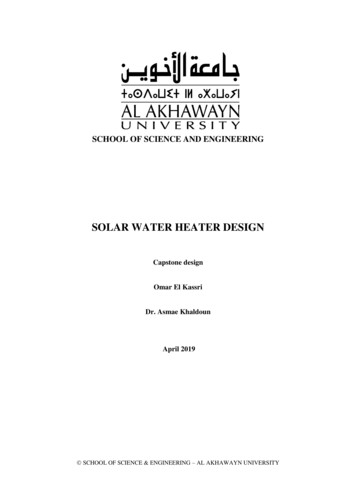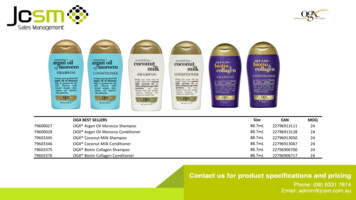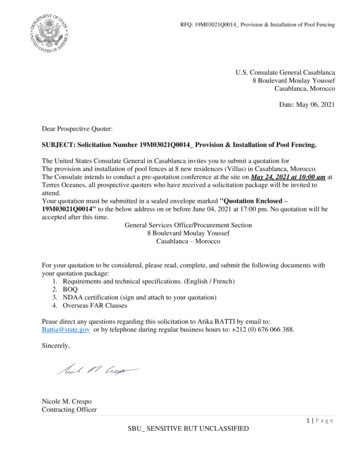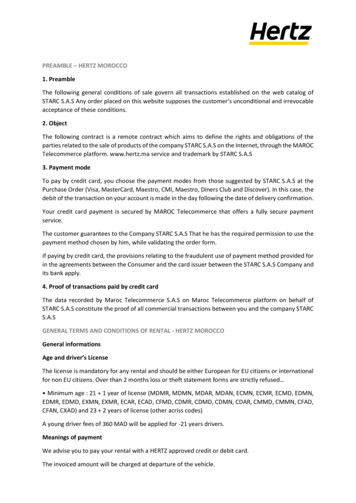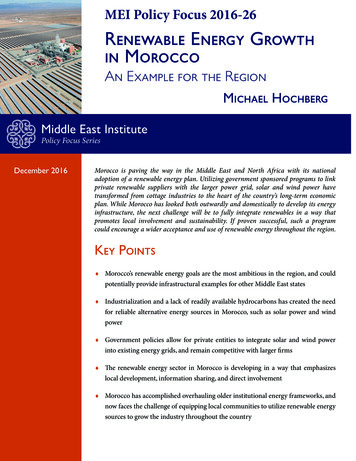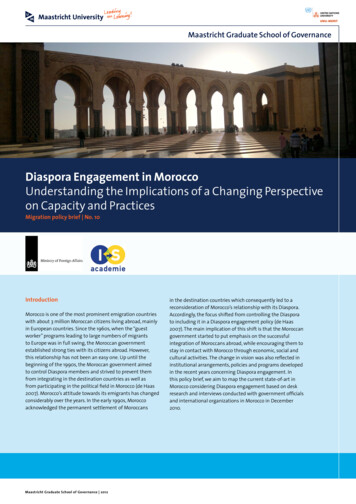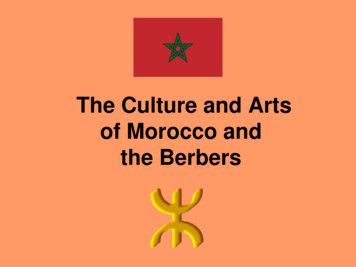
Transcription
The Culture and Artsof Morocco andthe Berbers
MoroccoLocation: Northwest Africa, on Atlantic oceanPart of the Maghreb - the name for the alliance ofNorth African countries - Algeria,Tunisia, Libya, MauritaniaPopulation: 33 million. Area: Slightly larger than CaliforniaLanguage: Official written language, (not spoken): Classical ArabicUsed for official government documents & business: FrenchCommon spoken language: Moroccan Arabic (not written)Common spoken & written: Berber (called Tamazight)Political System: Constitutional Monarchy with a Legislative & Judicial branch. KingMohammad VI is the head of state and spiritual leader and appoints the primeminister. Morocco gained independence from France in 1956.Controversy: The southern region of Morocco, aka Western Sahara has been adisputed territory since 1991. Western Saharan people (Sahrawis) would like toestablish their own country. Currently 200,000 are refugees in Algeria. The U.N.proposed that W.S. be a domestic autonomous region like Tibet. No resolution.Economics: Newsweek magazine, August 2010, listed Morocco 6th in the world amongstsmaller population countries in economic development for such sectors as: servicessuch as tourism, telecom and textiles, mining (world's third-largest producer ofphosphorus), fishing, salt, construction, manufacturing. Still dependent too much onagriculture which employs about 45% of the population. The King has beeninstrumental in developing the economy and owns many businesses. When the Kingproposed building more dams Moroccans engaged in farming went from 70% to 45%.Alfalfa, tomatoes, wheat are large crops.
The king of Morocco, Muhammad VI, is unique among all rulers in the Islamicworld as he bears the title ‘Commander of the Faithful.’Below, the King at Throne Day on July 31st, the anniversary of his coronation,a national holiday.
Religion: 99% Muslim (mostly Sunni moderates, Sufis, and some Shi‘ah). A large Jewishcommunity lived in Morocco before the creation of Israel, numbering approximately265,000 in 1948. Between 7,000 and live there now.Ethnic makeup: 99.1% Berber & ethnic Arabs, .7% Other (Christian), .2% JewishClimate: Mediterranean which means rain in the winter and dry in the summer. Morocco is anArid environment on the edge of the Sahara desert (which is mostly rock with only somesand dunes). There are extensive rivers on the Western Plains where they get 15‖-20‖ raina year. On the eastern side of the country they receive 2‖-3‖ rainfall (a drought andsalt in the water in the south are problems). In the extremely dry areas farming takes placein the oases areas called Palmeraie‘s (linear oases) often with ancient systems ofirrigation (see photo to right).Their architecture is considered Africanatebecause of it‘s thick-walled adobe clay buildingssimilar to those found in much of Africa.Moroccan women: They have more rightsthan many other Arab countries due tothe Kings‘ support – many now are judges,scholars, and teach/support otherwomen to grow. Not all women cover upwith the traditional Hijab headscarf –Morocco is considered to be a moderateIslamic country.
Morocco’s Regions1.2.3.4.5.6.7.8.9.Mediterranean Coast &RifFes, Meknes and MiddleAtlasEastern MoroccoNorth Atlantic CoastSouth Atlantic CoastMarrakech and HighAtlasRiver Valleys and dunesAnti AtlasSouthern Morocco
Education Education is a high priority no in the country. Since 1999 a new programwas instituted by the government called ―Decade of Excellence‖ – to teach theimportance of changing Morocco through education and to reform the educationsystem to include preschool education. The government is also trying tointroduce the American system of education.Preschool - children go to koranic schools where they learn Arabic.Primary school – 6 – 12 years (Muslim children read Koran, Jewish read theTorah). Many children leave school at 12 years old to help their parents farm.Secondary school – 13 – 15 years – called ―Idadiya‖High school (16-18) called ―Taniwiya‖History & Geography taught in ArabicMath & Social Sciences taught in FrenchUniversity – taught only in French (so you must read, write and speak French!)
The Berbers The name Berber is a variation of the Latin original word ―Barbarian‖, earlier in historyapplied by the Romans specifically to their northern hostile neighbors from Germania. TheBarbary coast, on the coast of northwest Africa was named after the Berbers because theyand Arabs pirated ships going to the Mediterranean Sea. The Berbers call themselves"Imazighen", meaning the free. Berbers are non-Arabic tribes that are often referred to asArab-Islamic. Over the last several hundred years many Berber peoples have converted toIslam. History: The Berbers are known to have been in North Africa at least in 3000 B.C. They arethought to have come across northern Africa. Many early Roman, Greek, and Phoeniciancolonial accounts mention a group of people collectively known as Berbers living in northernAfrica. Other waves of Berber immigration came in the 3rd and 11th centuries. Some Berberstrace their lineage to Yemen. Population: Morocco has the majority of Berbers, 10.4 million (40% of the population).These can be divided into three main groups with different dialects: the Riffians, the Chleuhand the Central Moroccan Amazigh. They are also in neighboring Saharan countries: Algeria,Tunisia, Libya, and Egypt, with mainly Tuareg Berbers living in Mauretania, Niger, Mali, andBurkina-Fasso. Two-thirds of Berbers live in rural and mountainous areas, most beingfarmers. Prior to independence in 1956, half of Morocco were Berbers. After this Arabicbecame the main language and an Arabization period began (government-initiated agenda tocounter French colonial values). Housing is clay, adobe, stone and/or brick, and for nomadic Berbers, tents made out of wooland goat hair. Often the extended family will have a few dwellings on a property with a wallaround them (also called a compound) so that they have an area to garden, keep goats, etc.But more families live in separate housing more than ever before.
Many people dress inBerber style bluerobes. These arecarpet sellers inOurzazate, in theheart of Morocco &Berber territory.Morocco‘s mixture ofraces and cultureincludes Berbersintermarrying withArabs and otherAfrica tribal people.
An artist who also runs a Jewish artifact ―museum‖ in Ourzazate.
A Berber encampment from high on a sand dune.
A Berber Toy Tent
EconomyBerbers are often portrayed as nomadic people crossing the deserton camels, but most are farmers in the mountains and valleysthroughout northern Africa. Some do trade throughout the region.Historically Berber merchants were responsible for transporting goodsby camel caravans. There were basically five Trans-Saharan traderoutes which extended across the Sahara from the northernMediterranean coast of Africa to the great cities, which are situated onthe southern edge of the Sahara, such as Timbouctou in Mali. Fromthere the goods were distributed throughout the world.Traditionally, Berbers raise sheep, cattle and goats. Some Berberswork in flourmills, do woodcarving, quarry millstones, and makepottery or jewelry. Women generally do the cooking and caring for thehome and children, weaving, and pottery. Today, many Berbers workin Spain or France as migrant workers and send money home to theirfamily.
Most Berbers were originally Nomadic (moving their home and notstaying in one place to graze their sheep and goats and take advantageof better weather, living in tents as here).
These Berber families move to summer and winterclimates that benefit their families and goats & sheep.
A Berber woman on a windy day in her summer home. Wesnapped this from the road with a long lens.
Political SystemsBerber society is made up of families who are members of a tribe which is a member of aclan of tribes. Each tribe has a chieftain. The French had the tribes organized intoconfederations to control them. After independence the King created 16 regions of Moroccobased around geographic areas.Most Berbers were farmers. At one time, tilling the land was considered the work of the lowerclasses, while the upper classes were merchants. Usually, groups of sedentary Berbers paidallegiance to a locally appointed headman, who in turn reported to the noble who consideredthe village his domain. As time has passed, however, these sedentary farmers have beenable to accumulate wealth while the trans-Saharan trade routes diminished in importance.They were also given political status by colonial and postcolonial administrations.The Zawiya & the SaintsBerber communities haveclans/families claimingdescent from the Prophet(Sharifs), who are regardedas holy men havingsupernatural powers. Theyact as mediators for thevillage and people cancome to stay in the Zawiyaif they have problems andbe protected.
Religion Most Berbers are at least nominalfollowers of Islam, and many strictlyobserve Islamic traditions. Most of thefeasts are observed and celebrated, butthe fasting that is required duringRamadan is often excused for thosewho travel. Most Berbers are Sunni*Muslims of the Maliki school. Like most followers of Islam in northernAfrica, many Berbers believe in thecontinuous presence of various spirits(djinns).Shia:Sunni:Sufis:
Social Organization / Customs & Traditions:Tribal Life: It‘s all about the tribe. Fard is a word which means that “the individual is nothingwithout the tribe”. The nuclear and extended family comes first and is most important. Familymembers can live together, or at least most members stay close, and the women and children ofan extended family work together in the home. To be alone is thought to be a sad condition.Children are cared for by older children in the extended family. Patriarchy is strong. Men workoutside the home as farmers, merchants in their shops, educators etc. Women and children alsowork in the fields, carrying crops home etc. They also make artisanal crafts with palms and reedsand other natural materials. Children have to help their families by doing chores. Some familymembers move away to cities inMorocco and to Europe (to be migrantworkers) and America and send moneyback to the extended family. Their valuesystem is ―I‘m going to work for my familyand make it possible for everyone to livebetter‖.(Right) Guests are held in high esteemand treated very well. Hospitality is takenvery seriously.
The Spiritual Dimension in Berber Design James Jereb, in his book The Arts and Crafts of Morocco, describes Berberdesigns as "a testimony not only to the meditative and aesthetic power thatdecoration holds for them, but a faith in supernatural power. Many pieces are valuednot because of appearance alone--perhaps because of their form or the way in whichthey are decorated--but because they may contain a power known as baraka, aconcept deeply embedded in Moroccan religious beliefs and crucial to theunderstanding of all artistic traditions in Morocco.Baraka has many meanings in Morocco, but it is principally the positivepower of the saints. It is a source of inspiration among most Moroccanartisans.Baraka permeates all things to varying degrees; not only can it exist injewelry, talismans and other manufactured objects, such as ceramics and textiles, itis also thought to suffuse plants, such as henna and oleander, and incenses, such assandalwood and myrrh. This power is transferred to objects and textiles by the use ofa particular artistic vocabulary of symbols, designs, motifs, colors and techniques thatprotect the object, creator and consumer." (The Arts and Crafts of Morocco p. 13)Baraka is sought and used to deal with the darker forces of life, curingillnesses and protecting oneself against the evil jnoun (spirits--the source of theEnglish word "genie") and the evil eye.Berber symbols are included in the design of everyday objects to protect theobject as well as the person who uses or wears it. These motifs appear in all aspectsof the Berber artisanal tradition, including pottery, leatherwork and textiles, not tomention all types of personal adornment. Berbers found many ways to adornthemselves with jewelry, tattoos and henna. It is mostly Berber women who aretattooed. Because tattoos are forbidden by Islam, many women have found otheroutlets for placing their protective motifs by including them in textiles they weave andin jewelry and henna. Thus, the designs that are drawn in henna on the hands andfeet of a bride on the eve of her marriage are these same protective and nurturingsymbols that have evolved throughout centuries of use.
The Arts: God loves beauty, God is beauty. – Islamic idealWomen are the carriers of the cultural & ethnic identitythrough their art forms – jewelry, carpet & fabricweaving, fashion, and embroidery.
The Marriage RitualNecklaces,headdresses andbracelets using silver,coral, amber, beadsColors & Designshave meaning
Makeup for awedding or specialritual is verydistinctive. Blackcharcoal is put on theeyebrows and aseyeliner, with rougeon the cheeks. Noticethe tattoo on her chinand nose.
Vintage photos from southern Morocco.Notice the woman’s tattoo on forehead andchin.Although tattooing is no longerpracticed by most Amazigh women, inthe recent past, when a girl reachedpuberty, sometime between the ages ofeleven and fourteen (a time thatgenerally coincided with her firstmenstrual cycle), her mother, aunts, orfamily friends would tattoo her face andwrists. Tattooing was a rite of passage,marking a girl‘s transition intowomanhood. Usually small groups ofgirls were tattooed at the same time,making it a very social activity, sharedand passed on among women.* Today tattooing is a violation ofIslamic law so no one under 30 hastattoos.
Bert Flint who started theTiskiwin Museum in Marrakechto preserve the arts of Saharan people.
Necklace pouches for carrying things.
Jewelry Silver – earrings,pendants,necklaces, beads Amber, coral Cabachon-cutgems (convex,unfaceted) Enameling withcolor (not shownhere) Leather work
Distinctive Berber symbols on silver necklace.
Silversmith demonstration of making asouthern Moroccan cross in Amezrou, Zagora.The silversmiths and the blacksmiths, trainedby the old Jewish population, are still usingthe models left by them to make fibula (pinsto hold garments together) and medallions.
Amulets or Talisman An Amulet is a piece of jewelry usually hungabout the nect and thought to be a magicalprotection against evil or disease.A Talisman is similar but the definition saysit‘s marked with magic signs or believed togive its‘ bearer supernatural powers orprotection.The Hamsa (Khamsa)One of the most popular amulets usedthroughout the Middle East & North Africa isthe open hand which is used as a defenseagainst the ‗evil eye‘. It is a protective amuletthat represents blessings, power, andstrength. The symbolism of the hand raised,palm outwards is to repel some threatenedevil.The 5 fingers represent the five pillars ofIslam and are said by some to represent themost sacred people in Islam – Muhammad,Ali, Fatima, Hassan and Husain.It is believed to have originated with theancient practices of the Phoenicians.An eye is often designed into the center ofthe hand.The renewed interest in Kabbalah andmystical Judaism is a factoring in bringing thehamsa pendant back into vogue.
The Mulhafa: A new elegantstyle for women, originated bySahrawi women (people of theSahara) of southern Morocco. Tiedyeing is common as well as brightcolors.
Embroidered veils & head coverings called Tahruyt With the decline of tattooing as a means of conveying expressive and social functions, its artisticforms and symbolism have been transferred to the embroidered "veils" (13) or head coverings,called tahruyt, worn by Amazigh women in some areas of southern Morocco. In the early and middletwentieth century, these long, sparsely decorated, indigo-dyed cotton cloth head coverings wereworn simply as modesty garments. Indigo is today primarily imported into the region, but it wascultivated in southern Morocco from as early as the sixteen century until as late as the 1960s(Balfour-Paul 1997:205). The use of indigo head coverings distinguishes Amazigh women insouthern Morocco from many other Amazigh groups in the Middle Atlas and High Atlas Mountains ofMorocco, who once commonly wore wool shawls rather than any type of "veil" or head covering(Fig. 13). South of the Atlas Mountains the climate becomes drastically hotter and drier, making itpractical for women to wear some type of covering to protect them against harsh sun and sandstorms. Indigo-dyed cotton coverings are ubiquitous throughout the Saharan regions of Africa, asthe use of indigo was thought to have cosmetic and medicinal benefits, conditioning women‘s skinand improving their complexions. The Kel Tamacheq women, popularly referred to as Tuareg, anAmazigh group living in the desert regions of Niger, Algeria, Burkina Faso, and Mali, commonlywear indigo-dyed head coverings and clothing (Fig. 14). Hassaniya Arab women living throughoutMauritania and northern Senegal also cover themselves with indigo head coverings (Du Puigaudeau1970:13).In the 1970s, coinciding with the disappearance of tattoos, Amazigh women began to embroiderelaborate vegetal motifs on their tahruyt, demonstrating the living and dynamic nature of their arts(Fig. 15). Women begin by embroidering a central band, called a tanammast, which forms a groundline for the other embroidered motifs that appear to rise up or grow out of it. The tanammast dividesthe cloth of the tahruyt into two equal halves and women align their patterns symmetrically so thatthe motifs are always balanced bilaterally, the designs on both the top and bottom of the tanammastserving as mirror images of each other (Cover).As with those used in weaving, these embroidered motifs associate women with the natural world.The women I spoke with consistently described the motifs adorning their head coverings as"flowers," "bird tracks," "shafts of wheat," "trees," or other natural objects associated with fertility,plenty, and prosperity. For instance, the neon green zig-zag designs embroidered on the borderhanging over the woman‘s left shoulder in the Cover picture was said to resemble pigeon prints. Insouthern Morocco, oral poetry and songs often compare women to pigeons. (14)From Amazigh textiles and dress in Morocco: metaphors of motherhood article by Cynthia Becker, Phd.
Design Symbols & Their Meaning:The head covering on the cover on this book, fromwhich most of the research on women shaping Berberidentity shows the most common motif found onembroidered head coverings, a small triangle that is calledtakhbasht, which means "claws" and which women told melooks like the marks animal claws make on the ground—another example of a tikselt or "metaphor." The trianglemotif is also omnipresent, as in other Amazigh textiles,jewelry, and tattoo designs. Flower motifs, clear referencesto fertility, are also embroidered with curvilinear stitches(Fig. 15). In sum, the embroidered motifs on the tahruytoften appear to create a large, fertile landscape coveredwith vegetation.Colors used in the decoration of the tahruyt alsosuggest a connection between the fertility of the landand the fertility of women. Women purchase previouslydyed wool yarn in the market for use in their embroideryand colors are categorized into light and dark hues.Although purple, bright blue, pink, neon green, andother colors are embroidered on the dark cloth, thesecolors fall within the basic color palette of red, green,yellow, and black. In the Cover picture, circular motifs inpink and red, colors categorized as light, resembling thesunlight, are embroidered above the other motifs. Theyhover like the sun above the other designs, creating acomposition that resembles the natural world and itsplentifulness, connecting women to fertility.- Cynthia Becker, Phd.
The Art of Body Adornment with Henna(also a cash crop for southern Morocco)
Some reasons for Women Using Henna & tattooingThroughout Morocco, substances containing baraka, such as saffron or henna, arebelieved to infuse the body with positive healing energy and are applied during riteof-passage ceremonies that typically include blood flow, such as male circumcisionor the loss of female virginity during a wedding ceremony, as on the saffron-paintedbride. Pollution categories in Islam are based on the idea that the inner and outerbodies are separated into discrete, mutually exclusive elements that must be keptapart. However, certain substances can cross from the outer physical body to theinner spiritual body and purify the inner body, especially those substances containingIbarakabelieve(Marcusit is not 1992:74).coincidental that Moroccan women chose to tattoo their bodies withsubstances containing baraka to symbolically enhance their bodies after firstmenstruation, a crucial moment in the life cycle. Tattoos can be seen as a means ofboth augmenting women‘s bodies and of publicly marking their transition from childhoodto womanhood, as a physical and ever-present symbol of their prestige as usefulmembers of the society, who ensure the survival of the group through their ability togive birth.Particular tattoo motifs, including a variety of geometric designs, generally varied fromgroup to group in Morocco; however, tattoo designs also reflected personal stylepreferences.
Tattoos for women in the Middle East In Iran, it was common for upper class women to have patterns tattooed on their chins. The designswere sometimes very elaborate, and resembled that of a beared. Along side the chin tattoos, it wascommon for women to tattoo their lips blue, as it was considered to embody beauty. Beliefs attached totattoos in the middle east often corresponded with thinking the wearer was imbued with magical power,these tattoos often times were dots or small crosses. They usually adorned the hands, and feet, theybelieved that they either provided strength or protection.Tattooing is nevertheless common among the Berbers of North Africa, where small designs withsymbolic meaning are used (mainly by women). Egyptian Christians often have a cross tattooed ontheir hand or wrist. These designs are very simple – often crudely done – and we are not aware of anyArab equivalent tot he elaborate tattoos used, for example by the Maoris and Pacific islanders.However, in this day and age, the demand for tattoos among Iranian, and other middle eastern womenhas exploded Iranian who are tattooed, however must keep them under wraps due to the authorities.The art of tattoo in the middle east is forbidden by religious scriptures. In despite of this restriction thereare those who have a need or desire to get tattooed. Some see it as a way to allow themselves to getcloser to God while others use it as a way to remember some great event in their life. Tattooing wasalso used as a rite of passage.For a non-permanent skin decoration in the Arab world is practiced mostly by women and takes theform of designs on hands and feet using henna, which fades away after a few weeks. The complexpatterns seen throughout the Middle East are normally achieved using stencils which can be boughtcheaply in the souks (markets).
Rug Styles and Symbols Traditional Berber carpets contain distinctive patternsand colors and are woven from sheep wool or camel hair(you can also find them made from nylon and olefinmaterial). The materials are hand-washed and naturallydyed from saffron yellow, to wild mint green, andfrom pomegranate and henna. These carpets are knownfor their strong geometric designs, and have been datedthem as far back as the Marinid era (Berber dynasty).Carpets in the Middle Atlas generally have a traditionaldiamond grid. Amazigh textiles, because of the tribes' relative isolationin rural areas, have preserved ancient weaving techniquesand mystic symbolism. In this society even the wool itselfhas special protective powers. The Berber tribes developed a variety of weaves to beadaptable to different climates. The rugs in the mountainshave larger loops, are more loosely knotted to provideprotection against the cold. In warmer climates the rugsare made with a finer weave. Berber weaving is highly dependent on the femaleculture, and is passed down traditionally within the home.The young apprentice is expected to learn the differentlooping techniques, patterns, color ranges and motifs.Historically women wove carpets for their families, andmen traditionally produced carpets that were morespecialized as professional masterweavers.
The bold colors, in depth patterns and weaving techniques of different regionshave their own distinct style. Each tribe has a signature pattern and commonlyunfold a story, revealing acts of ceremony, or designs that often relate to fertilityand protection. Like any other type of abstract art, interpretations can be betterunderstood with additional knowledge of the culture, songs and legends.Women ArtisansAssociations allover Morocco areempoweringwomen byallowing them tomake extramoney. A Berberrug with thediamond patternand symbolsbelow, made bywomen in a smallvillage and soldat theassociation.
Berber Women’s Textile & Carpet Designs(from Lucien Viola’s Vintage collection and book)
Regions & Confederations of Berber Tribes of Moroccolive in the High Atlas Mountains Region in the north, Mid-Atlas MountainsRegion in the middle, and Anti-Atlas Mountains Region in the south
Ceramic Art of Berber womenThe domain of Berber pottery extendswest to east from Morocco (Middle Atlas andRif) to Tunisia and covers northern Algeria,from the Oran region to the Aurès Mountainsand Small Kabylia. The cradle of the mostrefined Berber production is Kabylia inNorthern Algeria.The Berber women use neither wheel nor kiln to make their pottery.The pieces are shaped by hand and cooked in the open air. In thisway, they more closely resemble objects discovered in archaeologicaldigs at megalithic burial sites in Northern Africa than they do ancientMediterranean pottery shaped on a wheel and cooked in a kiln. Thefragility and daily use of these objects explains why there are noexamples pre-dating the 19th century. It is the archaic style used tocreate the pottery that gives it its antiquity. The geometric patternsdecorating the pieces – which are also found on the women‘s textilesand tattoos – carry symbolic meaning, whose origin traces back to theNeolithic era and was present on all continents.
Tuareg BerbersTuaregs are known forwearing indigo bluecolored robes andturbans and leadingcaravans across theTrans-Saharan traderoutes as well as theirmusic now.
The Tuaregs Who are they: Tuareg prefer to call themselves Imouhar(en), Imashagen or Kel tamasheq. Tuaregs area mixture of Whites (Berbers) and Blacks (sub-saharan people). They speak Tamarshak, a dialect of theold Berber language, and have preserved an ancient script (Tifinagh) similar to that used by the ancientLibyans. Where do they live: They are a nomadic Berber people numbering some 1.5 million people and livingmainly in the Sahel states of Niger, Mali, Côte d Ivoire and Burkina-Faso, and in the Saharan districts ofthe Maghreb – Algeria, Tunisia, Libya, Mauritania and Egypt. There are even some tribes in Sudan, andBénin. They migrate over a huge area of the Sahara and the Sahel crisscrossing existing nationalborders. Their territory is essentially the Sahara desert, but the aridity of this part of the world forcesthem to camp in the various mountains emerging from the desert, of Mali Niger, and southern Political Life: Their political organizations extend across national boundaries and as a result they live inconstant strife with the central authorities. They live in tribal confederations that include the tribes of theAhaggar and Ajjer mountains in the north, and the Asben, Ifora, Itesen, Aulliminden and Kel-Tademaketin the south. Their virtual country has its spiritual and historic capital in Taddamakat in Mali. Anotherimportant city is Tagedda in Niger. Economy: In the past they were great raiders of caravans and of other tribes, provided guides for transSaharan caravans, exacted tribute from them and engaged in the salt trade. When there was no moretrade and desertification took over many moved to the Middle Atlas to settle. The terrible droughts of the70‘s and 80‘s hit them hard, killing most of their livestock and forcing many of them to look for jobs infarming, trade and industry. Southe6rners breed cattle and camels, and northerners mainly goats. Social organization & customs: Their society was feudal and hierarchical, and included noble,religious, vassal, craftsmen and slave classes which are now being gradually eroded. When on the movethey live in tents of red dyed skin. Adult males wear a distinctive blue veil over the lower part of the facewhich it is a shame for them to remove. Religion: They share with Arabs their culture and their Islamic religion. Maybe Christianity had a certaininfluence on them - Tuareg blacksmiths sculpt beautiful crosses. Even if religion plays an important rolein their life, they are not considered very devout. The main points of the religion are respected - prayer,abstinence from pork, observance of holidays.From: www.tuaregs.free.frwww.saharafragile.org
Tuaregs are known for their music (like world/trancemusic) and now play with electric guitars. The TuaregFestival is held each year in Nigeria.Moussa Ag Keyna of Toumast,Tuareg ―nomad rocker‖
Etran Finatawa,a music groupcombiningNiger andTuaregmusicians
Tuareg Silver jewelryAll Tuareg photos from TUAREG JEWELRY by Helene Hagan
Leather design, often used as saddles on camels.
Leather designs on camel saddle bags.
You can see the camel saddle bags below. Petroglyphs andpaintings such as the example on the right have been fo
Morocco Location: Northwest Africa, on Atlantic ocean Part of the Maghreb - the name for the alliance of North African countries - Algeria,Tunisia, Libya, Mauritania Population: 33 million.Area: Slightly larger than California Language: Official written language, (not spoken): Classical Arabic Used for official government documents & business: French



